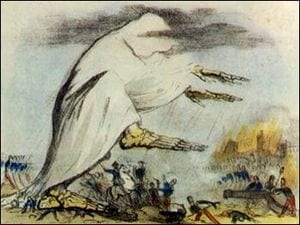
Kira Radinsky has written an algorithm that dissects old news stories and other Internet postings to look for past cause and effect, and then can alert us to possible disasters, geopolitical events, and disease outbreaks.
The New York Times might be a widely respected chronicler of past events, but can we use it to divine the future? Kira Radinsky, a 27-year-old Israeli computer prodigy dubbed the “web prophet” says yes.
Radinsky, who appeared this year on MIT’s prestigious list of top 35 inventors under the age of 35 (previous winners include the likes of Mark Zuckerberg, Larry Page, and Sergey Brin), and who started university at the age of 15 and received her Ph.D. in computer science at 26, has developed a unique system which she claims has already predicted the first cholera epidemic in Cuba in many decades, many of the riots that started the Arab Spring, and other important world events.
The complex computer algorithms she wrote collect immense volumes of electronic data–most notably several decades of New York Times archives but also anything from Twitter feeds to Wikipedia entries–and processes it to extract little-known cause and effect patterns that can be used to predict future events.
For example, she says, “If a storm comes two years after a drought, a few weeks [after the storm] the probability of a cholera outbreak is huge, especially in countries with low GDP and low concentration of clean water.”
This may seem fairly intuitive–people have been making similar predictions for thousands of years–but getting a computer to do it, and to analyze accurately the massive amounts of electronic data present on the web, is another matter. Even simple examples present complex challenges.
As an example, she points to a hypothetical headline that says there is an earthquake in Australia. “You want to predict what’s going to happen [next] so you look up your database and see that there was an earthquake in Turkey,” she said. “You need [your program] to understand that Turkey and Australia are [different] countries. So after an earthquake in Turkey, the Red Cross sent help to Ankara. But to predict that an earthquake in Australia would result in the Red Cross sending help to Ankara is incorrect … so [you] have to build a different function from the data to fix that.”
It all started as a game, Radinsky says, when she was playing with Google Trends in 2007 (Google Trends a public web facility that analyses the volume of searches for a particular query). She quickly found out that she could predict some of what people would search for–such as hurricanes–based on news reports of recent world events. Then she asked herself if she could adapt this mechanism to predict future developments.
The Latest on: Predict The Future
- Every patient is unique. Future doctors will wonder why we didn’t treat them that way | Opinionon April 30, 2024 at 4:03 am
Not everyone is Joe Average — and too many medical professionals rely on their own anecdotal experiences. | Opinion ...
- The future of jobs: What will work look like in 2034?on April 30, 2024 at 2:45 am
Where now for careers advice in a continually evolving world? In a four-part series, Dr David Oxley and Dr Helmut Schuster consider the future of careers and careers advice and students’ transition to ...
- Queen of Tears Fan Theories: Did Kim Ji-Won Predict Her Future During Her Hallucinations?on April 30, 2024 at 2:03 am
One theory speculates that when Hong Hae-In was hallucinating during the phase when she was diagnosed with the rare tumor, it was actually glimpses of her future. The fact that what Haein saw while ...
- Freezing-cold Patrick Mahomes draft grades prove NFL experts are terrible at predicting the futureon April 29, 2024 at 4:30 pm
Patrick Mahomes wasn’t always destined for greatness. In 2017, a future three-time Super Bowl winner was seen as a top-ten pick, at best, in the NFL Draft. Mahomes was a three-star QB and ...
- T-Mobile employees get AI superpowers to ‘predict’ and solve your problemson April 29, 2024 at 12:10 pm
T-Mobile is rolling out AI tools that act as an internal knowledge base, optimize retail interactions, and predict customer behavior.
- Predicting Parkinson’s: Can Retinal Thickness Unlock Future Cognitive Decline?on April 26, 2024 at 3:55 pm
A research collaboration between the University of the Basque Country (UPV/EHU) and Biobizkaia suggests employing a readily available, straightforward, and non-invasive method to track ...
- NextMarine: The Future of Saltwater Anglingon April 25, 2024 at 6:00 am
NextMarine represents the future of saltwater angling. Learn what technologies are coming to revolutionize how we boat, how we find fish and how we catch them..
- Divining the Futureon April 24, 2024 at 11:47 pm
“It is difficult to make predictions, especially about the future.” That adage is attributed to everyone from baseball’s greatest sage, Yogi Berra, to Nobel Prize-winning physicist Niels Bohr.
- Charting the Course: Entrepreneurs Predict the Future of Online Marketing from 2024 to 2025on April 23, 2024 at 3:06 am
Embarking on a journey through the digital landscape, we delve into the minds of visionary entrepreneurs to uncover their insights on the ever-evolving realm of online marketing. As we stand at the ...
- Why LLMs are predicting the future of compliance and risk managementon April 19, 2024 at 6:45 am
Don’t miss out on the chance to gain insights from industry experts, network with like-minded innovators, and explore the future of GenAI with customer experiences and optimize business processes.
via Bing News
The Latest on: Electrospun medicines
- Medicine and the Machineon April 26, 2024 at 5:00 pm
Subscribe Now Wisdom From a Scottish GP: The Lost Art of Convalescence The final Medicine and the Machine podcast guest, physician and author Gavin Francis, shares his approach to keeping his ...
- Preservatives in Topical Ophthalmic Medications: Historical and Clinical Perspectiveson April 25, 2024 at 5:00 pm
Patients may be subject to a variety of different topical medications when undergoing treatment for ocular disease. Preservatives are added to multidose medication bottles to inhibit microbial ...
- Two medicines for opioid addiction also help with compulsive gamblingon April 25, 2024 at 5:00 pm
Two medicines usually given to people who are addicted to opioid drugs also help with compulsive gambling. The finding suggests there may be similar brain circuits involved in behavioural ...
- Taking Multiple Medications? You May Need to Scale Back.on April 21, 2024 at 5:00 pm
And the older patients are, the more likely it is they’re taking even more medications. But taking many medicines simultaneously, known among medical experts as polypharmacy, increases people ...
- Army Medicine Newson April 18, 2024 at 5:00 pm
Provide ready and sustained health services support and force health protection in support of the Total Force to enable readiness and to conserve the fighting strength while caring for our People ...
- Shortages of life saving medicines has become ‘new normal’ for UK after Brexiton April 17, 2024 at 5:00 pm
Their warnings come following reports of the scarcity of vital chemotherapy drugs, such as cisplatin and carboplatin, and medicine for ADHD. Analysing freedom of information requests and public ...
- Cost-Based Pricing For Innovative Medicines Is Unviable And Harmfulon April 12, 2024 at 11:12 am
Barber et al. just published a fundamentally flawed study on diabetes medicines in JAMA Network Open (JNO). This study wrongly suggests that cost-based pricing accurately values innovative on ...
- A Complete List of Diabetes Medicationson April 4, 2024 at 5:00 pm
Doctors prescribe different medications to treat type 1 and type 2 diabetes and help control your blood sugar. Treatment may vary depending on your diagnosis, health, and other factors.
- Common medicines that are likely to get expensive from todayon April 1, 2024 at 3:30 pm
Prices of Diclofenac, Ibuprofen, Mefenamic acid, Paracetmol, and Morphine spike today under NLEM drugs due to NPPA's notice based on WPI data, impacting over 800 medications including Folic Acid ...
- These medications could make driving dangerous, the FDA warnson March 19, 2024 at 2:35 am
While most medicines are safe to take on the go, some may cause side effects that can interfere with the ability to operate a vehicle or heavy machinery, the agency warned in a notice on its website.
via Bing News









